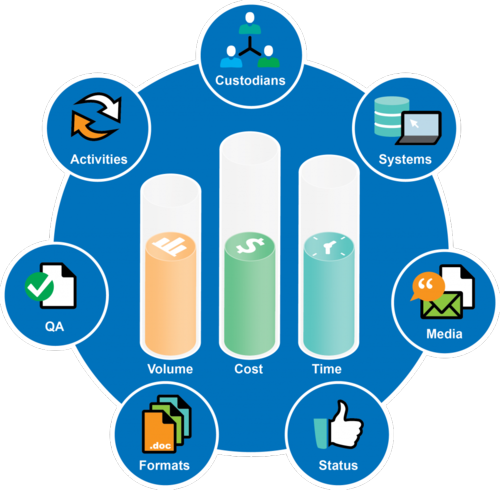eDiscovery Daily Blog
EDRM Publishes New Metrics Model – eDiscovery Trends

When I attended the Annual Meeting for the Electronic Discovery Reference Model (EDRM) last month, one of the projects that was close to a major deliverable was the Metrics project – a project that I worked on during my first two years as a participant in EDRM. Now, EDRM has announced and published that deliverable: a brand new Metrics model.
As their press release notes, the “EDRM Metrics Model provides a framework for planning, preparation, execution and follow-up of e-discovery matters and projects by showing the relationship between the e-discovery process and how information, activities and outcomes may be measured.” It consists of two inter-dependent elements: (a) The Center, which includes the key metrics variables of Volume, Time and Cost, and (b) The outside nodes, which identify work components that affect the outcome associated with the elements at the Center. There is no indicated starting node on the Metrics Wheel, because any of the seven nodes could be a starting point or factor in an eDiscovery project.
Information at the Center
The model depicts Volume, Time, and Cost at its center, and all of the outside nodes impact each of these three major variables. Time, Cost, & Volume are inter-related variables that fluctuate for each project.
Outside Nodes
Here is a brief description of each of the seven nodes:
Activities: Things that are happening or being done by either people or technology; examples can include: collecting documents, designing a search, interviewing a custodian, etc.
Custodians: Person having administrative control of a document or electronic file or system; for example, the custodian of an email is the owner of the mailbox which contains the message.
Systems: The places, technologies, tools and locations in which electronic information is created, stored or managed; examples of systems include shared drives, email, computer applications, databases, cloud sources and archival sources such as back-up tapes.
Media: The storage devices for electronic information; examples include: CDs, DVDs, floppy disks, hard drives, tapes and paper.
Status: A unique point in time in a project or process that relates to the performance or completion of the project or process; measured qualitatively in reference to a desired outcome.
Formats: The way information is arranged or set out; for example, the format of a file which affects which applications are required to view, process, and store it.
Quality Assurance (“QA”): Ongoing methods to ensure that reasonable results are being achieved; an example of QA would be to ensure that no privileged documents are released in a production by performing a operation, such as checking for privilege tags within the production set.
A complete explanation of the model, including graphics, descriptions, glossary and downloadable content is available here. Kudos to the team, led by Kevin Clark and Dera Nevin (TD Bank Group)!
So, what do you think? Do you think the model will be useful to help your team better understand the activities and how they impact volume, time and cost for the project? Please share any comments you might have or if you’d like to know more about a particular topic.
Disclaimer: The views represented herein are exclusively the views of the author, and do not necessarily represent the views held by CloudNine Discovery. eDiscoveryDaily is made available by CloudNine Discovery solely for educational purposes to provide general information about general eDiscovery principles and not to provide specific legal advice applicable to any particular circumstance. eDiscoveryDaily should not be used as a substitute for competent legal advice from a lawyer you have retained and who has agreed to represent you.
